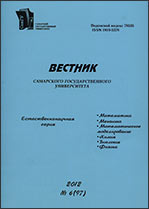|
|
Vestnik SamGU. Estestvenno-Nauchnaya Ser., 2014, Issue 10(121), Pages 116–129
(Mi vsgu456)
|
 |
|
 |
This article is cited in 1 scientific paper (total in 1 paper)
Mechanics
Waterflooding front moving task in dual periodical area: piston-like displacement case
V. I. Astafieva, A. E. Kasatkinb
a Samara State Technical University, Samara, 443100, Russian
Federation
b Samara State University, Samara, 443011, Russian Federation
(published under the terms of the Creative Commons Attribution 4.0 International License)
Abstract:
Water-oil contact moving task has a high significance in a waterflooding theory: it’s possible to improve oil recovering characteristics due to prediction of flow features for both liquids – oil and water displaced it. There is the simplest mathematical pattern for conjoint oil-water flow presenting: it is called “versicolor” liquids model and it suggests making oil and water physically identical to simplify solving process for water-oil contact moving task. However, another pattern was used in research described in this paper: it is called pistonlike displacement model and it supposes that oil and water physical characteristics, for example, viscosities, may be different. As for the oil-keeping reservoir pattern used in this research it was presented as homogeneous and infinity, with fixed thickness: furthermore its surface was covered by dual periodical lattice included production and injection wells in its cells.
Keywords:
waterflooding, piston-like displacement of oil by water, oil-water boundary, flood front, tracing task, singular integral equation, Weierstrass dzetta-function, areal sweep efficiency, waterbreak time.
Received: 18.01.2014
Citation:
V. I. Astafiev, A. E. Kasatkin, “Waterflooding front moving task in dual periodical area: piston-like displacement case”, Vestnik Samarskogo Gosudarstvennogo Universiteta. Estestvenno-Nauchnaya Seriya, 2014, no. 10(121), 116–129
Linking options:
https://www.mathnet.ru/eng/vsgu456 https://www.mathnet.ru/eng/vsgu/y2014/i10/p116
|

| Statistics & downloads: |
| Abstract page: | 194 | | Full-text PDF : | 180 | | References: | 36 |
|




 Contact us:
Contact us: Terms of Use
Terms of Use
 Registration to the website
Registration to the website Logotypes
Logotypes









 Citation in format
Citation in format 
